
The Do’s & Don’ts on How to Wash Microfiber Cloths & Mop Heads
As one of the most important developments in cleaning technology in recent years, the cleaning power of microfiber cloths and mop heads is hard to beat. The material’s fibers are repeatedly split in the manufacturing process to make microfibers that are then knitted into soft, reusable cleaning cloths that are 30 times finer than cotton. For cleaning industry professionals, the unique composition of microfiber makes it highly effective at trapping soil, removing bacteria and absorbing moisture.
With all of the benefits of microfiber cleaning technology, you want to protect your investment through proper care and cleaning. Microfiber is somewhat different from washing other materials, such as cotton cleaning cloths or cotton string mops, due to its unique properties and construction. To make your microfiber investment last and keep it performing at its highest level, follow these do’s and don’ts on how to clean microfiber cleaning cloths.
The Right Way to Wash Microfiber Cloths in a Washing Machine
You can potentially ruin a microfiber cloth or mop head if you do not launder it correctly. Microfiber is a delicate material that requires specific care to maintain its effectiveness and longevity. Our best advice is to read the specific care instructions from the manufacturer and always check the care label on your microfiber items. Overall, in general, you can follow these guidelines to maintain the quality and effectiveness of your microfiber products.
Washing and Drying Temperature
DON’T use high heat. Exposing microfiber to high heat, whether in the washing machine or dryer, can cause the fine fibers to melt or become damaged. This can lead to a loss of the cloth’s absorbency and cleaning abilities.
DO use cold or lukewarm water rather than hot water in the washing machine. Air-drying is the best option for microfiber, but if you choose to use a dryer, set it to a low heat or air-dry setting.
Fabric Softeners and Detergents
DON’T use fabric softeners and harsh detergents. Fabric softeners can clog the fine microfiber fibers, reducing their ability to pick up dirt and moisture. Harsh detergents and stain removers (those with dyes, fragrances and brighteners), oil-based soaps and bleach can break down the fibers and impact their performance.
DO use a mild liquid detergent. Delicate wash detergents are among the mildest as well as those labeled “free and clear.”
Washing Cycles
DON’T use aggressive washing cycles. Aggressive washing cycles with high agitation can cause the fibers to break down, reducing the cloth’s overall lifespan. Aggressive laundry washing cycles include heavy-duty, sanitary, whites, bulky, and power wash settings.
DO wash microfiber cloths and mop heads using the gentle or delicate cycle.
Wash Load
DON’T mix microfiber with other lint-prone items such as cotton towels or mops as this can cause lint to cling to the microfiber and impact its cleaning effectiveness. Also, overloading the washing machine can prevent the microfiber items from getting cleaned properly. It can also cause excessive friction that damages the fibers.
DO load microfiber cleaning tools properly and wash them separately.
Microfiber Storage
DON’T improperly store. Storing damp or wet microfiber items in a sealed container can lead to mold or mildew growth, which can damage the fabric.
DO make sure the cloths and mop heads are completely clean and dry and choose a storage area that allows for good air circulation to prevent moisture buildup. If possible, hang microfiber cloths and mop heads to allow air to circulate around them. You can use hooks, towel racks, or even a clothesline in a dry and well-ventilated space. If hanging isn’t an option, place them on open shelves. This ensures proper air circulation and prevents compression of the fibers.
While microfiber is generally resistant to UV rays, prolonged exposure to direct sunlight can lead to color fading and degradation of the fabric, so it’s best to store them in a shaded area.
Hand Washing Microfiber Cloths
If you don’t have access to a washing machine or would simply prefer to hand wash your microfiber cloths, here’s how:
- Fill a sink or basin with lukewarm water. Avoid using hot water, as it can damage the microfiber material.
- Add a small amount of mild detergent to the water. Make sure it’s a detergent that does not contain bleach or fabric softeners, as these can harm the microfiber.
- Place the microfiber cloths in the soapy water and allow them to soak for about 5-10 minutes. This will help loosen dirt and grime from the fibers.
- After soaking, gently agitate the cloths by swishing them around in the soapy water. If you notice particularly stubborn stains or dirt, you can use your fingers or a soft brush to lightly scrub the affected areas. Be gentle to avoid damaging the fibers.
- Drain the soapy water and refill the sink or basin with clean, lukewarm water. Rinse the microfiber cloths thoroughly to remove any soap residue. You may need to rinse them a few times until the water runs clear.
- Gently squeeze the water out of the microfiber cloths. Avoid wringing or twisting them, as this can damage the fibers.
- Hang the microfiber cloths to air dry. You can use a clothesline, a drying rack, or even a clean towel rack.
Innovative Microfiber Cleaning Products
Knowing how to wash microfiber cloths and properly caring for them is essential to maintain their quality and performance. Always check the care instructions provided by the commercial cleaning manufacturer and follow the guidelines provided to ensure that you’re laundering your microfiber cloths and mop heads correctly.
Unger’s lineup of microfiber products includes a variety of microfiber cleaning cloths; microfiber mop heads; high-reaching microfiber dusters; and microfiber window cleaning kits.
